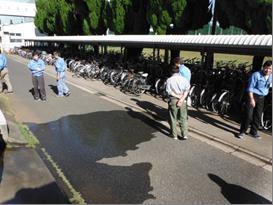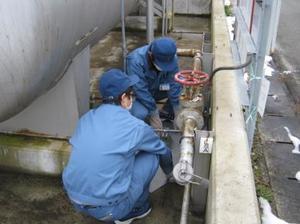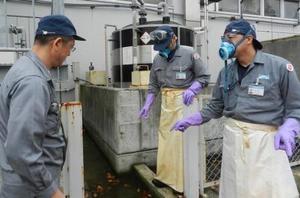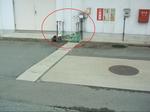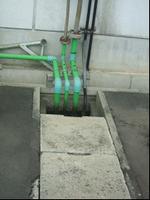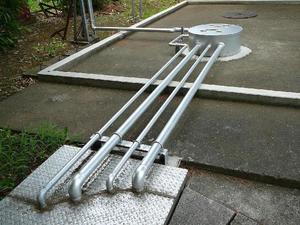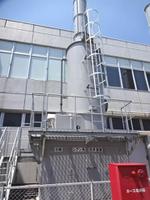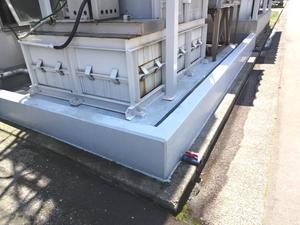Environmental Report 2018
Reducing Environmental Risks
Emergency Response
For tasks with a high risk of significantly affecting the environment, we have established emergency response procedures for each task, and we conduct procedure tests and drills.
・An example of high-risk work
| Transfer of fuel from tank truck to fuel tank (discharge due to disconnection of hose, etc.) |
| Transport of dangerous goods (discharge/underground seepage due to overturning of cans) |
| Operation of waste gas scrubber (discharge of air pollutants caused by abnormality) |
| Use of harmful substances in plating process (leakage to floor surface, pits, etc.) |
| Storage of harmful substances in storage tanks (leakage/discharge due to damage) |
Training to respond to leaks from drug storage tanks (HAE)
Prevention of Soil and Groundwater Pollution
The discovery of soil and groundwater contaminated with hazardous substances is on the rise in Japan due to the redevelopment of former plant sites and voluntary surveys. Since countermeasures after contamination has already occurred take a vast amount of time and money, this is gaining recognition every year as a massive social problem, and related laws and regulations are being put in place.
The JAE Group conducts risk assessments of its facilities that handle toxic substances and those associated with fuel oil, and takes countermeasures to prevent contamination, such as by double-walling underground storage facilities and pipes. This section introduces several activities to prevent contamination.
| 2010: | JAE assessed risk of leakage and seepage into the soil with regard to its facilities that handle toxic substances and fuel oil-related facilities, then began to raise its underground pipes, installing them above ground (JAE Akishima Plant) |
| 2013: | The JAE Group commenced inspections with regard to the aging and useful lifespan of environment-related equipment and at facilities designated for storage of toxic substances, and regularly replaces the main valves on collateral pipes and other parts at proper intervals so as to reduce the risk of leakage. (JAE Akishima Plant) |
| 2014: | The above-ground installation of pipes, that had run underground, for toxic substances and those related to fuel oil, which had been assessed as high risk, was completed. Accompanying equipment upgrades to clean emissions generated in the plating process, the wastewater cleaning process tower's retainer walls were recoated. (HAE) |
| 2015: | In order to construct the Comprehensive Assessment and Testing Building, the former plant was demolished. Soil testing confirmed that there was no contamination. (JAE Akishima Plant, former site of No. 4 plant) |
